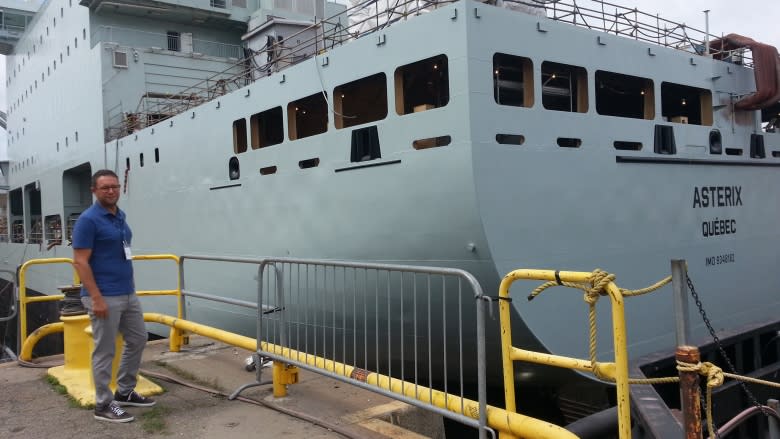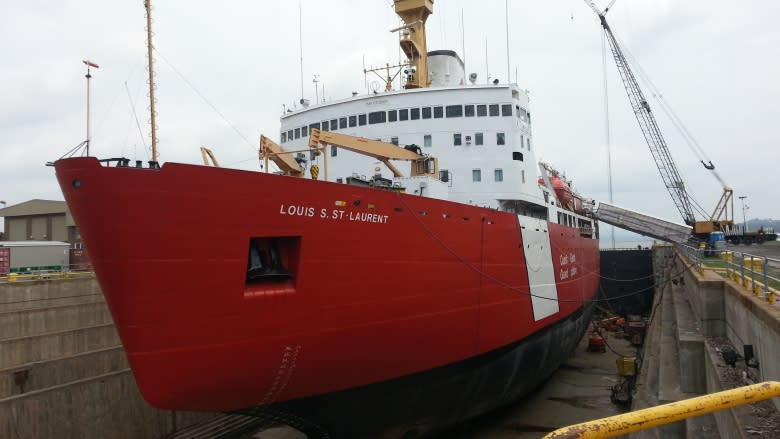Is Quebec City's troubled Davie shipyard making a comeback?
Five years after it faced bankruptcy, the Davie shipyard in Lévis, Que., unveiled a converted navy supply vessel in a public ceremony this week that was as much about the company's new swagger as it was about the ship.
Davie welcomed the public, along with dozens of navy officers, community leaders and politicians, to an open house to unveil the ship, which is stern-to-bow in drydock with another completed project — a refit and upgrade of the Canadian Coast Guard icebreaker, Louis S. St-Laurent.
"This is quite a spectacular sight," Alex Vicefield, the chair of Davie and CEO of its parent company, Inocea, told CBC News. "Here we've got the Louis St-Laurent, the largest vessel in the Coast Guard fleet, sitting alongside the largest vessel in the naval fleet."
The navy supply vessel is a converted container ship called MV Asterix that was purchased by Davie and is being transformed into what the company says is the largest naval vessel delivered by a Canadian shipyard to the Royal Canadian Navy.
When it's completed, the Resolve-Class auxiliary oiler replenishment ship will have a helicopter deck, accommodations for up to 350 people, and a large medical facility with an operating theatre that can be used in disaster relief and humanitarian operations.
Delivery of the ship, expected this fall, will solve a big problem for the navy, which has been without its own supply vessels for more than two years and won't receive new ones until the mid 2020s. In the meantime, the navy has to rely on allies to refuel and re-arm its frigates at sea.
The supply ship will be leased to the federal government for five years at a cost of $668 million, with an option for an additional five years.
The shipyard with nine lives
Vicefield is head of the group that purchased the shipyard in 2012 from Upper Lakes Marine and SNC-Lavalin, a partnership that pulled the yard back from the brink of bankruptcy in 2011 — just in time to bid on the multi-billion dollar federal contracts to build combat and non-combat vessels.
But when those contracts went to Irving Shipbuilding in Halifax and Seaspan Marine in Vancouver, the partnership dissolved.
That opened the doors to Vicefield's group, which is based in Britain and Monaco. In the five years since it took over, the workforce at the yard has grown from a dozen or two office and maintenance staff to 1,369 workers today.
"When we came along, we made promises," Vicefield said. "We said to the provincial government specifically that we're going to employ 500 people and that we're going to put in $300 million in new financing to get projects built," Vicefield said.
"And here we are today with nearly 1,400 people with a billion dollars of private financing put into the shipyard, no government money, and we've launched three ships, we've re-fitted and repaired another six, and we're just about to launch Canada's largest-ever naval vessel."
Troubled waters
It hasn't all been smooth sailing, however.
Davie has had to find a way to rid itself of one inherited project from a decade ago to build three ships for the Norwegian company Cecon to service the petroleum industry.
With offshore exploration in decline worldwide, Vicefield said there was no need for any more vessels. It completed one vessel and managed to get out of the other two, but it's believed that everyone involved lost money, including the federal government, though no one will confirm how much.
Davie has also struggled with the contract to build two new ferries for the government-run Société des Traversiers du Québec (STQ) — the first ferries in North America to be powered by liquified natural gas.
The two parties have been at odds because construction costs have risen above the original $125 million budgeted in 2011.
Vicefield, however, says progress is being made towards a resolution and the two ferries, which will link Tadoussac and Baie Ste. Catherine across the Saguenay river, will be delivered early next year.
"These are heavily complex vessels, that are double-ended with ice-breaking capabilities as well," Vicefield said.
"The government could have taken the short route using a much simpler vessel, but I think it took a bold move to demonstrate the environmental efficiencies of the vessel, and to really be a pioneer in that kind of high-end, cutting-edge ferry construction."
With these projects winding down, Davie has its eye on other major federal shipbuilding repair work that should go to tender soon, including a contract for the overhaul of 12 navy frigates over the next decade.
Cloud of controversy remains
Davie is still waiting for the other shoe to drop in the investigation of Royal Canadian Navy Vice-Admiral Mark Norman, who was suspended earlier this year when the RCMP opened an investigation into allegations he leaked secret federal Cabinet information to officials at Davie and its sister company, Federal Fleet Services.
Irving Shipbuilding had complained about the Conservative government's awarding of the supply vessel conversion contract to Davie. When the Liberals took over, they began a review, but then backed away when the issue became public.
Vicefield did not address that controversy directly but acknowledged the deeply competitive nature of the Canadian shipbuilding industry.
"I said when we first came here that we're not here to steal other peoples' contracts. But clearly we're a shipyard that is not just the largest shipyard in Canada, we're about five times the size and the capacity of the other shipyards."
Shipbuilding, Vicefield said, is also "highly political."
"It's huge jobs, and it's a huge amount of politics because of that," he said
"I mean we have 900 Canadian suppliers — about 600 or 700 of which are in Quebec, so the benefits you provide to the region are huge. We estimate that we have actually contributed about $3 billion in economic benefits to the region since we started in 2012. So it's something worth fighting for."



